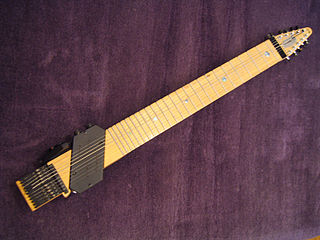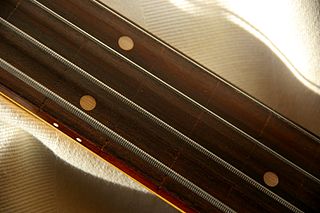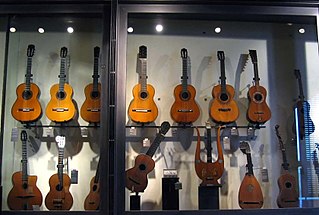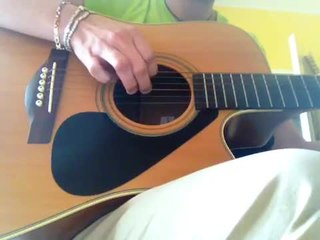
The bass guitar, electric bass or simply bass, is the lowest-pitched member of the string family. It is a plucked string instrument similar in appearance and construction to an electric or an acoustic guitar, but with a longer neck and scale length, and typically four to six strings or courses. Since the mid-1950s, the bass guitar has largely replaced the double bass in popular music.

The guitar is a fretted musical instrument that typically has six strings. It is usually held flat against the player's body and played by strumming or plucking the strings with the dominant hand, while simultaneously pressing selected strings against frets with the fingers of the opposite hand. A plectrum or individual finger picks may also be used to strike the strings. The sound of the guitar is projected either acoustically, by means of a resonant chamber on the instrument, or amplified by an electronic pickup and an amplifier.

Sweep picking is a guitar playing technique. When sweep picking, the guitarist plays single notes on consecutive strings with a 'sweeping' motion of the pick, while using the fretting hand to produce a specific series of notes that are fast and fluid in sound. Both hands essentially perform an integral motion in unison to achieve the desired effect.

The Chapman Stick is an electric musical instrument devised by Emmett Chapman in the early 1970s. A member of the guitar family, the Chapman Stick usually has ten or twelve individually tuned strings and is used to play bass lines, melody lines, chords, or textures. Designed as a fully polyphonic chordal instrument, it can also cover several of these musical parts simultaneously.
The fingerboard is an important component of most stringed instruments. It is a thin, long strip of material, usually wood, that is laminated to the front of the neck of an instrument. The strings run over the fingerboard, between the nut and bridge. To play the instrument, a musician presses strings down to the fingerboard to change the vibrating length, changing the pitch. This is called stopping the strings. Depending on the instrument and the style of music, the musician may pluck, strum or bow one or more strings with the hand that is not fretting the notes. On some instruments, notes can be sounded by the fretting hand alone, such as with hammer ons, an electric guitar technique.

Fingerstyle guitar is the technique of playing the guitar or bass guitar by plucking the strings directly with the fingertips, fingernails, or picks attached to fingers, as opposed to flatpicking. The term "fingerstyle" is something of a misnomer, since it is present in several different genres and styles of music—but mostly, because it involves a completely different technique, not just a "style" of playing, especially for the guitarist's picking/plucking hand. The term is often used synonymously with fingerpicking except in classical guitar circles, although fingerpicking can also refer to a specific tradition of folk, blues and country guitar playing in the US. The terms "fingerstyle" and "fingerpicking" also applied to similar string instruments such as the banjo.

A MIDI controller is any hardware or software that generates and transmits Musical Instrument Digital Interface (MIDI) data to MIDI-enabled devices, typically to trigger sounds and control parameters of an electronic music performance. They most often use a musical keyboard to send data about the pitch of notes to play, although a MIDI controller may trigger lighting and other effects. A wind controller has a sensor that converts breath pressure to volume information and lip pressure to control pitch. Controllers for percussion and stringed instruments exist, as well as specialized and experimental devices. Some MIDI controllers are used in association with specific digital audio workstation software. The original MIDI specification has been extended to include a greater range of control features.

A string is the vibrating element that produces sound in string instruments such as the guitar, harp, piano, and members of the violin family. Strings are lengths of a flexible material that a musical instrument holds under tension so that they can vibrate freely, but controllably. Strings may be "plain", consisting only of a single material, like steel, nylon, or gut, or wound, having a "core" of one material and an overwinding of another. This is to make the string vibrate at the desired pitch, while maintaining a low profile and sufficient flexibility for playability.

The yueqin, also called a moon lute or moon guitar, is a traditional Chinese string instrument. It is a lute with a round, hollow soundboard, a short fretted neck, and usually four strings. It is an important instrument in the Peking opera orchestra, often taking the role of main melodic instrument in lieu of the bowed string section.
A nut, on a stringed musical instrument, is a small piece of hard material that supports the strings at the end closest to the headstock or scroll. The nut marks one end of the vibrating length of each open string, sets the spacing of the strings across the neck, and usually holds the strings at the proper height from the fingerboard. Along with the bridge, the nut defines the scale lengths of the open strings.

The qinqin is a plucked Chinese lute. It was originally manufactured with a wooden body, a slender fretted neck, and three strings.photo 1[ photo 2] Its body can be round,photo hexagonal, or octagonal.[ photo] Often, only two strings were used, as in certain regional silk-and-bamboo ensembles.photo In its hexagonal form, it is also referred to as meihuaqin.

The following outline is provided as an overview of and topical guide to guitars:
The Fender Stringmaster is a series of console steel guitars produced by Fender from 1953 to 1980.
A pick slide or pick scrape is a guitar technique most often performed in the rock, punk or metal music genres. The technique is executed by holding the edge of the pick against any of the three or four wound strings and moving it along the string. As the pick moves across the string, the edge of the pick catches the string's windings in rapid succession causing the string to vibrate and produce a note. This rapid rattling of the pick's edge against the windings also gives the resulting note a grinding or grating quality.

A guitar synthesizer is any one of a number of musical instrument systems that allow a guitarist to access synthesizer capabilities.
The Roland GR-500 was a guitar synthesizer. Manufactured by the Roland Corporation and FujiGen in 1977, it was one of the first guitar synthesizers.

The Gibson Robot Guitar is a limited-edition self-tuning Gibson guitar, typically a Les Paul. The first run of limited edition Robot Guitars was exclusively made up of Les Paul bodies. Five different Gibson models were available ) with Robot Guitar features: The Robot Les Paul Studio, Robot SG, Robot Flying V, Robot X-plorer, and a Robot Les Paul Junior. Developed by Chris Adams, its most notable feature is that it uses an onboard computer to automatically tune itself. This is not the first guitar to be able to tune itself, but it is regarded as the most modern, unique, and non-invasive self-tuning model available, because it does not employ cams or cantilevers throughout the body of the guitar. The non-limited edition SG and Les Paul Studio are available in a variety of finishes. The Flying V and Explorer are only available in metallic red. The price can range from about $1,000-$3,000 or more for custom options. In the case of the "Original 1st Production" Robot guitar, the only finish available was Blue Silverburst nitrocellulose, a color which Gibson has stated will never be used on any other Gibson guitar. The original Robot guitar also featured headstock and neck binding which are not standard on any current Les Paul Robot as well as a chrome truss rod cover with "Robot Guitar" engraved. The production version featured 22-fret rosewood-bound or white-bound ebony fingerboard with figured acrylic trapezoid inlays, white-bound headstock with MOP Gibson logo and flowerpot inlay or unbound headstock with screened logo, three-per-side robotic Powerhead Locking tuners, tune-o-matic Powertune bridge, Powertune stop tailpiece, two chrome-covered humbucker pickups, four knobs, three-way pickup switch, Neutrik jack on side of guitar, chrome hardware.

The 3rd bridge is an extended playing technique used on the electric guitar and other string instruments that allows a musician to produce distinctive timbres and overtones that are unavailable on a conventional string instrument with two bridges. The timbre created with this technique is close to that of gamelan instruments like the bonang and similar Indonesian types of pitched gongs.
A third bridge can be devised by inserting a rigid preparation object between the strings and the body or neck of the instrument, effectively dividing the string into distinct vibrating segments.

Guitar picking is a group of hand and finger techniques a guitarist uses to set guitar strings in motion to produce audible notes. These techniques involve plucking, strumming, brushing, etc. Picking can be done with:

Eric Singer is a multi-disciplinary artist, musician, programmer and electrical, robotic and medical device engineer. He is known for his interactive art and technology works, electronic and robotic musical instruments, fire art and guerilla art.















